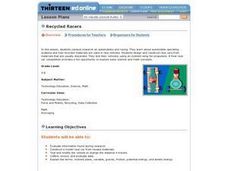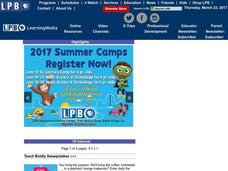Curated OER
"Da" I's Have It: A Fun Look At The Eye
Students study the human eye. In this science lesson plan, students construct 3 models of the human eye and take part in a play that highlights the parts of the eye.
Curated OER
Internal Anatomy: A Fun Look At The Digestive System
Students look at the functions of the body. In this biology lesson plan, students explore the functioning of some body part and construct a "living doll" composed of the body parts discussed.
Curated OER
The Great Tin Race
Middle schoolers construct and race tin can cars. In this motion lesson plan, groups build tin racers, complete timed runs, and record their data on the provided worksheet. The teacher leads a discussion comparing data between groups....
Curated OER
Meteor Monitor
Student's measure sporadic meteor activity. In this physics and astronomy lesson, 11th graders construct a dipole antennae, and build, test and wire a full wave diode rectifier between the dipole antenna and the laptop.
Curated OER
Who Will Care for the Water?
Learners discover how humans impact natural resources. In this environmental instructional activity, students identify water resources in the local area and construct a T-chart to compare the positive and negative effects humans have on...
Curated OER
Science and the Envrionment
Students utilize a digital camera to record interesting objects in their environment. In this ecology lesson, students participate in a mini-field trip around their campus as they take 2-3 pictures of the school environment. Students...
Curated OER
Solar Hot Box or Cooker
Students brainstorm about solar energy then construct a solar cooker to test the maximum temperature that materials can reach. In this solar energy lesson, students experiment and record temperature of water in their hot boxes while...
Curated OER
Where's the Point?
Learners examine runoff for the causes, the impact, and the solution. In this investigative lesson students construct a three dimensional model of a watershed and provide information of contaminated runoff to their audience.
Curated OER
Kites
Learners build a kite while integrating math and science. In this kite building lesson, students construct a blueprint and apply mathematical formulas while constructing a kite. They use appropriate flight and kite terminology to...
Curated OER
Snowflake Catching
Students catch snowflakes. In this science lesson, students use black construction paper to catch snow that is falling and then write about the experience. A game, a song, a craft, and a recipe are all included with the lesson.
Curated OER
Investigation: Blast Off!
First graders explore physics by participating in a class experiment. In this flight instructional activity, 1st graders create a spinner using construction paper and snap cubes which fly when spun right in class. Students make...
Curated OER
Jumpy Dolls
Students are challenged to design and construct a jointed figure that moves in a motion something like jumping jacks when a string is pulled.
Curated OER
Decomposition vs. Synthesis Reaction
Students define the term chemical reaction, identify the reactants and products in a chemical reaction, distinguish between decomposition and synthesis reactions and construct reactions using food items.
Curated OER
Spiders - KidPix
Students answer questions after a story is read aloud, identify and recall the three major body parts of a spider (head, body and 8 legs), construct a spider when given parts of a spider on a handout, and draw and decorate a spider using...
Curated OER
Recycled Racers
Students research automobile operating systems in relation to racing. They design and construct vehicles from recycled material which they race to study the concept of propulsion.
Curated OER
Modeling Geologic Time
Pupils design, construct and interpret a model of geologic time and investigate change through geologic time.
Curated OER
Starry, Starry Night
Students, using construction paper, and an empty black film canster with no lid, create their own night sky full of stars that can be seen in the middle of the day.
Curated OER
Cell Factory
Young scholars examine the basic structures and functions of cells. They design and construct a factory cell model where each factory part corresponds to a cell part.
Curated OER
Solar Oven
Students construct a solar oven using cardboard, duct tape, aluminum foil and other materials. They use the solar oven to cook something and keep a journal of their project.
Curated OER
Design a Running Shoe for a Triathlete
Students examine the design and construction of athletic footwear. They analyze the magnitude and directions of forces on the foot and leg in different sports, interview people, and design a running shoe for a triathlete.
Curated OER
FREE STANDING STRUCTURE
Students demonstrate basic construction skills by building a free standing structure. They compute the cost of the structure.
Curated OER
PHYSICS OF FLIGHT
Ninth graders study the basic principles of flight, including the Bernoulli Principle and Newton's Laws. They construct and study model aircraft
Curated OER
Human Traces
Students create and construct human skeletons by rubbing casts of bone impressions on paper, and then label most important components of human skeleton.
Other popular searches
- Geometry Construction Skills
- Geometry Construction
- Sentence Construction
- Construction Paper Pizza
- Clay Construction Techniques
- Building Construction
- Construction Paper Art
- Construction Math
- Bridge Construction
- Lego Construction
- Construction Book
- Construction Materials

























